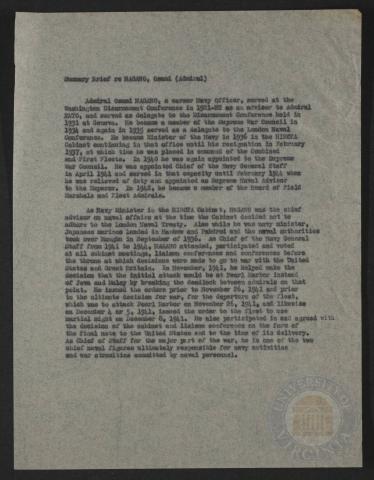
Page 1
| Parent | Summary Brief about Osami Nagano |
|---|---|
| Date | |
| Language | English |
| Collection | Roy L. Morgan Papers |
| Box | Box 3 |
| Folder | 1946 [IMFTE] (IPS) Translations of interrogations. |
| Repository | University of Virginia Law Library |
Summary Brief re NAGANO, Osami (Admiral)
Admiral Osami NAGANO, a career Navy Officer, served at the Washington Disarmament Conference Is 1921-22 as an advisor to Admiral KATO, and served as delegate to the Disarmament Conference held in 1931 at Geneva. He became a member of the Supreme War Council in 1934 and again in 1935 served as a delegate to the London Naval Conference. He became Minister of the Navy in 1936 in the HIROTA Cabinet continuing in that office until his resignation in February 1937, at which time he was placed in command of the Combined and First Fleets. In 1940 he was again appointed to the Supreme War Council. He was appointed Chief of the Navy General Staff in April 1941 and served in that capacity until February 1944 when he was relieved of duty and appointed as Supreme Naval Advisor to the Emperor. In 1942, he became a member of the Board of Field Marshals and Fleet Admirals.
As Navy Minister in the HIROTA Cabinet, NAGANO was the chief advisor on naval affairs at the time the Cabinet decided not to adhere to the London Naval Treaty. Also while he was navy minister, Japanese marines landed in Hankow and Pakdroi and the naval authorities took over Hongku in September of 1936. As Chief of the Navy General Staff from 1941 to 1944, NAGANO attended, participated and voted at all cabinet meetings, liaison conferences and conferences before the throne at which decisions were made to go to war with the United States and Great Britain. In November, 1941, he helped make the decision that the initial attack would be at Pearl Harbor instead of Java and Malay by breaking the deadlock between admirals on that point. He issued the orders prior to November 26, 1941, and likewise on December 4 or 5, 1941. He also participated in and agreed with the decision of the cabinet and liaison conference on the form of the final note to the United States and to the time of its delivery. As Chief of Staff for the major part of the war, he is one of the two chief naval figures ultimately responsible for navy activities and war atrocities committed by naval personnel.
